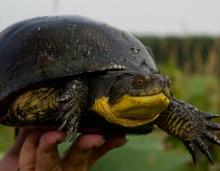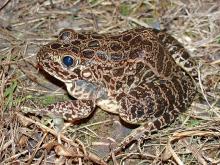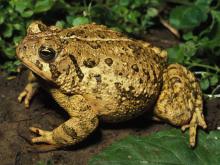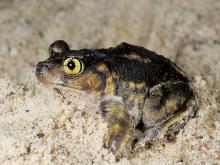Reptiles and Amphibians
Media

Species Types
Scientific Name
Regina grahamii
Description
Graham's crawfish snake is a medium-sized, dull-colored, semiaquatic snake that occurs throughout Missouri, but not in the Ozarks. Like most other snakes associated with water, it is often misidentified as a cottonmouth and killed out of unwarranted fear.
Media

Species Types
Scientific Name
Opheodrys vernalis
Description
The smooth greensnake has been declared extirpated from Missouri. If it is ever found again within our borders, it will probably be as small, relict populations in grasslands in the extreme northern counties. It differs from the similar rough greensnake by having smooth scales, a preference for grassland habitats, and a more northern distribution in Missouri.
Media

Species Types
Scientific Name
Thamnophis proximus proximus
Description
The orange-striped ribbonsnake is a type of gartersnake named for the attractive orange or yellow stripes running the length of its body, alternating with wide black stripes. It is found statewide, but seldom far from water.
Media

Species Types
Scientific Name
Emydoidea blandingii
Description
Blanding’s turtle has an oval, moderately high-domed upper shell and a long head and neck. This turtle is endangered in Missouri and occurs only in the extreme northern corners of the state.
Media

Species Types
Scientific Name
Terrapene carolina triunguis
Description
The three-toed box turtle usually has three hind toes. Its high-domed shell usually has a top ridge and is olive or brown with faint yellow or orange lines. Look for it in woodland habitats.
Media

Species Types
Scientific Name
Lithobates areolatus circulosus
Description
A very secretive species, the northern crawfish frog spends most of its time hidden burrows, typically those made by crayfish. It is restricted to native prairie or former prairie areas and is a species of conservation concern in Missouri.
Media

Species Types
Scientific Name
Anaxyrus americanus (formerly Bufo americanus)
Description
American toads are well-known and occur statewide. Missouri has two subspecies: the eastern American toad in the northern half, and the dwarf American toad in the southern half.
Media

Species Types
Scientific Name
Pseudacris crucifer
Description
The voices of spring peepers are a true announcement that winter is ending. These small, slender frogs can be several overall colors, but seeing an X on the back is a good way to ensure your identification.
Media

Species Types
Scientific Name
Scaphiopus holbrookii
Description
The eastern spadefoot is a stout, toadlike amphibian with large, protruding eyes, vertically oval pupils, short legs, and large feet. In Missouri, it occurs in eastern counties along the Mississippi River and in the Bootheel.
Media

Species Types
Scientific Name
Anaxyrus cognatus
Description
Unlike other true toads in Missouri, the Great Plains toad has a raised hump between the eyes on the snout. Look for it along the Missouri River floodplain, from the Iowa border to about Hermann.
See Also
About Reptiles and Amphibians in Missouri
Missouri’s herptiles comprise 43 amphibians and 75 reptiles. Amphibians, including salamanders, toads, and frogs, are vertebrate animals that spend at least part of their life cycle in water. They usually have moist skin, lack scales or claws, and are ectothermal (cold-blooded), so they do not produce their own body heat the way birds and mammals do. Reptiles, including turtles, lizards, and snakes, are also vertebrates, and most are ectothermal, but unlike amphibians, reptiles have dry skin with scales, the ones with legs have claws, and they do not have to live part of their lives in water.





















